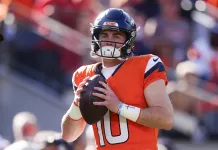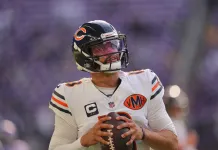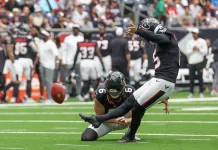A hot debate going into last year’s NFL draft centered on the Cincinnati Bengals, who needed to find immediate help for quarterback Joe Burrow: Would it be wiser for the team to use the No. 5 overall pick on an offensive lineman or wide receiver?
The Bengals opted to run with Ja’Marr Chase, Burrow’s former favorite target at LSU, and the rookie receiver was a catalyst in Cincinnati’s first Super Bowl appearance since 1988.
A year after the first three picks of the draft were used on quarterbacks, wide receivers will grab the spotlight when the first round plays out on Thursday, April 28 in Las Vegas.
“This is the first year in a long time that you’re not talking about a quarterback going in the first five or maybe first 10 picks, and that’s the biggest storyline to me,” Red Rock sportsbook director Chuck Esposito said. “A lot of teams need dynamic wide receivers, and I think you’re going to see six — and maybe seven — go in the first round.”
A week ago, in my first mock draft for Point Spread Weekly, I projected seven receivers to go in the first round and recommended Over 5.5 (-165) — the opening number at DraftKings — as a best bet. The price has moved to -250.
Esposito, who opened the Station Casinos Round 1 WR prop total at 6 (-115), said, “I thought there would be one-way play at 5.5, so that’s why we put it up at six. I would go Over 5.5 in a heartbeat.”
The draft stage is set in Las Vegas, yet it’s ironic the Raiders do not have a first-round pick, as they traded it to Green Bay for wide receiver Davante Adams in a mid-March deal that is contributing to a reshaping of the receiver market.
Adams and Tyreek Hill, a six-time Pro Bowl wideout who was traded from Kansas City to Miami in March, each hauled in contracts worth around $30 million per year. The aftershocks from the Adams and Hill trades are expected to be felt in this draft, as teams focus on wide receivers who can make an early impact and play on cost-friendly rookie contracts.
VSiN host Mike Pritchard, who played nine seasons in the NFL as a wide receiver, was the 13th overall pick by Atlanta in 1991. One of four receivers to get called in the first round, Pritchard has studied this year’s class at the position and is high on several prospects.
%%offer%%
“I was drafted into the NFL when free agency was becoming a reality,” Pritchard said. “At that time, rookie first-rounders would instantly make more money than established stars in the league. By the time I retired in 2000, veteran players (NFLPA) had one main objective — to make sure established veteran players were going to make more money than drafted players. The last two CBA agreements pretty much cemented this notion. We are now seeing highly-productive wide receivers getting contracts in excess of $20 million all because of free agency.
“The NFL has several ways to control costs of players. The obvious one is the draft, and because of the recent CBA agreements the teams can control costs longer. I believe we will see a run on wide receivers in the first round.”
Chase’s success for the Bengals last season should encourage NFL coaches and general managers to prioritize the wideout position, but when handicapping the first round of the draft, consider the deeper importance for teams to keep star wide receivers under control with the fifth-year option that comes with first-round contracts.
“Star QBs are making $40 million per year and now star wide receivers are making $20 million per year,” Pritchard said. “The combined $60 million between two players makes up almost 30 percent of the current salary cap. This is a big reason the Packers and Chiefs had to part ways with their elite wide receivers. I see more teams anticipating this situation and therefore will draft more wide receivers in the first round.
“If you notice, more and more wideouts are developing faster in the college ranks and entering the NFL sooner. The NFL recognizes the large number of playmakers available for the drafting process. We could see a run on the wide receiver position for a few years.”
The NFL has become a passing-oriented league — more scoring is beneficial for the excitement of the game — and Pritchard noted the increased influence of wide receivers makes it logical for teams to reload with playmakers.
In the 2021 draft, five receivers were picked in each of the first two rounds. In the 2020 draft, six receivers went in the first round and seven receivers went in the second round. In this draft, edge rushers, receivers and offensive linemen are expected to account for more than half of the 32 first-round picks.
“The NFL is a perimeter game and teams are employing three wideouts on almost every play,” Pritchard said. “NFL executives and coaches that I have spoken with often see edge rushers, linebackers and wide receivers as the best players available on the board. We know there’s going to be a run on edge rushers and we know there’s going to be a run on wide receivers, too. When those runs are going to happen is why this draft is so interesting to me.”
King, citing a factor that will complicate the mock draft process, said, “This is a fluid draft and trades are going to have a big impact on the sequencing.”
Will there be an early run on quarterbacks? That question leads to my second-best bet on the prop board.
Quarterbacks drafted in the first round: Under 3.5 (-175)
Three quarterbacks — Liberty’s Malik Willis, Pittsburgh’s Kenny Pickett and Cincinnati’s Desmond Ridder — appear in the first round in several mock drafts. A fourth candidate is Mississippi’s Matt Corral. Willis and Pickett appear to be locks, with Corral gaining late steam. It seems unlikely Corral and Ridder both go in the first, and the truth is this QB class is not especially inspiring.
DraftKings is offering this prop at 2.5 (Over -250). In the Las Vegas market, Boyd Gaming has posted the highest number at 3.5. If four quarterbacks go in the first round, NFL executives are either dumb or desperate.
VSiN host Shaun King, a second-round pick by the Buccaneers in 1999, played quarterback in the NFL and has studied the top prospects in this draft. His assessment is harsh and could be telling, if the quarterbacks are drafted lower than many expect.
“I don’t have any of them with a first-round grade,” King said. “I don’t think Atlanta or Seattle are going to go quarterback (in the top 10). I wouldn’t be surprised if none went in the first round or three went.”
Kenny Pickett draft position: Over 10.5 (-185)
In my first mock draft, Pickett went No. 6 overall to Carolina, but that’s changing. Panthers coach Matt Rhule needs to win next season, and neither Pickett nor Willis appears to be the answer to Rhule’s dilemma. Rhule could decide to trade for a veteran — Baker Mayfield and Jimmy Garoppolo are available — and possibly trade down in the draft for an offensive lineman.
The beginning of this draft could be similar to 2013, the last year no quarterback was drafted in the top 10. I’ll play the William Hill prop line instead of the DraftKings number of 12.5 (Over -120).
Saints to draft Malik Willis (%plussign% 900)
It’s a new era in New Orleans. Drew Brees and Sean Payton are replaced by Jameis Winston and Dennis Allen. Winston will be the starter this season, but Allen likely has his eyes on potential quarterbacks for the future. Willis’ strengths are his athletic ability and high character. The Saints, who hold the 16th and 19th picks, could snag Willis if he falls — or the team might move up in a trade. This is a small bet on a hunch.
Ahmad Gardner draft position: Under 7.5 (-200)
Scouts are hot on “Sauce” Gardner from Cincinnati as the top cornerback in the draft, and some indicate he might be the best defensive player on the board. I had Gardner going No. 7 to the Giants in last week’s mock draft and now suspect he’ll be picked earlier. Again, I’ll pay a higher price for the William Hill prop line instead of the DraftKings number of 5.5 (Under -115).
Derek Stingley Jr. first cornerback drafted (%plussign% 250); draft position: Under 11.5 (-150)
The price on “Sauce” to be the first corner picked seems too high at -450. There are teams that prefer Stingley, and the Lions, who hold the second pick, might be one of those teams. If Michigan defensive end Aidan Hutchinson does not go first, Detroit will take him. If Hutchinson is off the board, it’s a guess what happens next.
In 2019, when LSU won the national championship, Stingley was a freshman who made six interceptions in 15 games. At that point he was considered a future top-five pick, but injuries derailed his past two seasons. Stingley ran a sub-4.4-second 40 and vertical jumped 38.5 inches at his pro day.
It’s tempting to put small long-shot bets on the William Hill odds for Stingley to be the No. 2 pick (30-1) and No. 3 pick (100-1), by far the best odds available.
George Karlaftis draft position: Over 18.5 (-130)
The defensive end from Purdue did not put up eye-popping sack numbers in his last two seasons, and there’s impressive depth at his position in this draft. Karlaftis is the fifth- or sixth-ranked edge rusher, which means he could go as high as 14th or slip near the end of the first round. I project him to be picked somewhere in the 20s.
I’ll probably wait until early draft week to make more draft plays for two reasons — it’s still somewhat early in the information cycle with the final week revealing more leaks, and additional books such as Circa, South Point and Westgate will be posting props soon, so it’s always critical to compare draft position numbers and prices.





